The Icelandic Economy: The 1999 fiscal budget and current economic developments. (News release, October 1, 1998)
1. Economic policy
The main thrust of economic policy in the past several years has been to bring the Icelandic economy more in line with neighbouring countries. Monetary and fiscal policy are geared towards maintaining stability in the economy and increasing reliance is placed on liberalization and increased competition in markets for goods, services and financial assets. The central government is undergoing extensive restructuring through sales and corporatization of government enterprises, and a number of small municipalities are merging into larger units, partly in order to take on many of the local-oriented tasks that up to now have been performed by the central government.
The shift in policy emphasis towards market forces and away from sporadic government market
intervention has contributed to economic stability. It did much to help the private sector restructure itself and has been instrumental in reducing inflation from the long-endemic double digit figures to a level on par with neighbouring countries. During the past two years economic growth has been quite strong and there has been an upsurge in domestic demand. Inflation, however, has been moderate, largely because of a tight monetary and fiscal policy stance.
GDP growth 1988 - 1999
(1988=100)
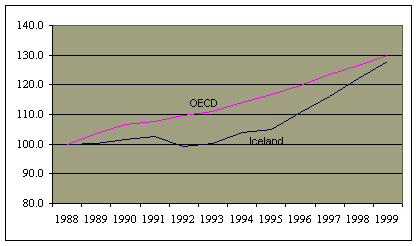
The present economic climate is charcterized by a positive outlook for the fisheries sector, strong private sector demand and a temporary upswing in investment. As a consequence, the current account deficit has sharply increased this year. Present wage agreements run mostly until the year 2000 and a major upheaval in nominal wage rates is therefore unlikely. Some wage drift must, however, be expected, particularly in sectors with labour shortages, such as the construction industry and health care. This is being countered by stronger fiscal finances and a surplus on the fiscal budget for 1999. Moreover, below-the-line fiscal transactions will generate a large financial surplus that will be applied towards retiring government debt. Monetary policy will be kept restrictive.
Main economic assumptions
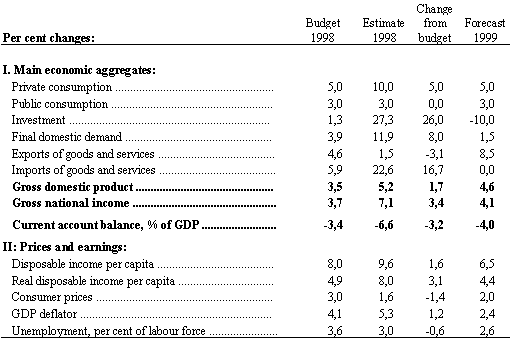
2. Current economic developments and outlook
The Icelandic economy has gone through a period of rapid growth since 1994. Growth has been particularly strong in 1998, and the terms of trade have improved considerably at the same time, leading to an unusually large increase in gross national income. This has been reflected in a strong increase in real disposable incomes and thus in private consumption. Large investment projects have been under way in the course of the year, thus leading to a reduction in unemployment rate to a level as close to full employment as it is ever likely to get. The sharp increase in private consumption along with a jump in imports of investment goods have, however, led to a substantial current account deficit, well above what is acceptable in the long run.
Current account
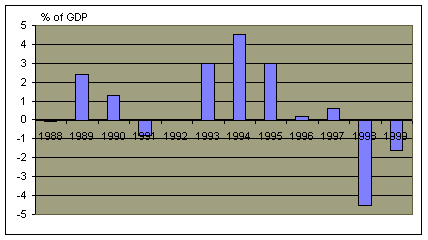
Present forecasts for 1999 indicate that the rapid upswing in demand will not continue. Non-recurring investment projects will abate as will the rise in consumer demand. Exports are expected to rise by 8.5% in real terms, mostly due to a 30% increase in exports of aluminium and ferrosilicon. Marine exports are expected to increase by 3% and service exports by 7,5%. Aluminium exports are increasing because the new aluminium plant at Grundartangi is going into full production. Imports are likely to remain broadly unchanged on 1999, largely due to the decline in imports of investment goods from this year's high level.
3. Fiscal developments in 1998
Fiscal finances on a cash basis have improved sharply in the course of this year, reflecting on one hand the revenue impact of the better than expected economic upswing. On the expenditure side, however, future pension liabilities have turned out to be considerably higher than assumed in the budget. This is largely because salary agreements concluded with government employees in 1998 assumed that a large portion of supplemental pay would be transferred into basic salaries, on which pension accumulation is based. This shift in pension arrangements was difficult to assess at the time of the budget's formulation and has turned out to exceed budget assessments by 9.3 billion krónur. This explains the bulk of the 12 billion excess in expendi-ture over the budget. Of the 2.7 billion remainder, 0.9 billion is due to salary agree-ments and revised pay scales and 1.6 billion is attributable to expenditure decisions undertaken by contract or decided upon by the Althing. A number of expenditure posts have exceeded budget estimates for a total of about 1.1 billion, such as in the health sector. Other expenditure items, such as interest payments, child allowances and social security payments, are below budget by a total of about 1 billion.
Treasury finances
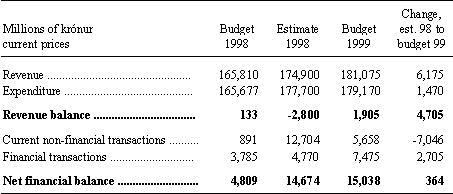
On an accruals basis, the budget is expected to be in deficit by 2.8 billion, equivalent to 12 per cent of GDP. Since accrued payments exceed cash outlays by some 12 billion - representing expenditures which will be paid out over future years - the actual demand impact of the budget is better assessed by the net financial balance which is expected to show a surplus of close to 15 billion, all of which is available for a reduction in debt. This is the first time in many years where the government finds itself in the situation of not having to borrow fresh funds in the market to meet its needs. The generation of a financial surplus is largely being used to retire foreign debt.
4. Fiscal reporting reform
The Government Financial Reporting Act which was passed in 1996 came into effect at the beginning of 1998. Its major impact was upon the presentation of the budget and the reorganization of the government accounts. The most immediate impact was that, as of the beginning of 1998, all government revenue based on law and/or regulations were included in total government revenue, and commensurate expenditures on the expenditure side. Previously, a large number of revenue sources were either outside the budget altogether or subtracted from expenditures of those agencies to which the revenue source was attached. This reform in the government accounts actually lifted the budget totals by more than 20 billion krónur, thus creating a break in time series of government finances. Furthermore, all revenue and expenditure will be budgeted and accounted for on an accruals basis, whereas previously the budget was exclusively cash-based.
The new regime of government accounting standards will serve to sharpen government management. They are more in line with present-day corporate accounts and serve to elicit financial information that will highlight management performance. Full accounting for future pension liabilities is also an important element in assessing government debt and future debt payments.
5. The 1999 budget
The 1999 budget bill is being presented to the Althing at the beginning of October. The Althing will have the budget under consideration for the next three months and pass the budget shortly before Christmas. The revenue surplus on an accruals basis amounts to 1.9 billion krónur, 0.3 per cent of GDP. The net financial surplus is expected to show a surplus of 15 billion krónur, 2.5 per cent of GDP, about the same as in 1998, thus exerting a strong offsetting impact upon the expansion in economic activity.
Revenues. The strength of fiscal finances stems from the fact that revenue is cyclically influenced. Both direct taxes on income as well as indirect taxes on expenditure are rising in concert with expanding economic activity, whereas restraint is excercised on the expenditure side. Total revenue is forecast to rise by just over 6 billion krónur from the estimate for 1998 to the budget figure forecast for 1999. Taxes on income and profit are expected to increase by 2 billion to 42 billion in 1999. The personal income tax is exstimated to yield 32.2 billion despite a reduction of 1 percentage point in the central government tax rate to 26.4%. The personal withholding tax, including the share of municipalities, will thus have been reduced from 42% in 1996 to 38% in 1999. Furthermore, the personal contributions to pension funds that may deducted from income before tax will rise from 4% of income by an additional 2 percentage points.
Treasury revenue
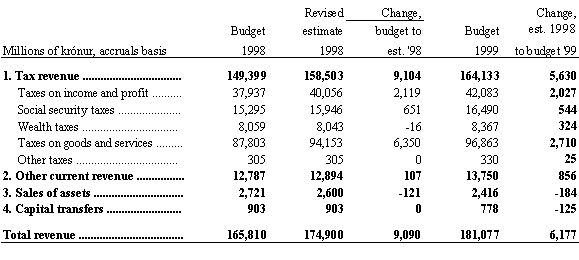
The forecast on the yield from the personal income tax is based on the assumption that wages will rise by 6% between the averages of 1998 and 1999.
The corporate income tax is expected to yield 7 billion krónur in 1999, an amount similar to the estimate for 1998. This forecast is somewhat uncertain. The tax on aluminium production is subject to world prices for aluminium ingot which are low for the time being. Furthermore, many companies still own a substantial carry-over of losses from previous years which they can use to offset current taxes. The corporate income tax assessment is subject to revision during the Althing's consideration of the budget bill.
Social security taxes are expected to rise by some 550 million krónur or 3.4% to 16.5 billion. The payroll tax, intended to meet the needs of the general social security scheme, is expected to increase by about 1 billion, but this is being offset by a lower contribution to the Unemployment Insurance Fund due to less unemployment.
Wealth taxes are estimated to yield about 300 m. kr. over the 1998 for a total of 8.4 billion krónur in 1999.
Taxes on goods and services constitute the largest category of government revenue and are estimated to yield a total of close to 97 billion krónur in 1999. The value added tax is the single most important tax on goods and services and is estimated to yield 61.5 billion krónur, 1.8 billion more than this year. This estimate is based on the forecast of the National Economic Institute of changes in prices and general turnover. Private consumption is estimated to increase by 5% and general imports are thought to remain broadly unchanged from this year, following an increase of about one-quarter in 1998.
Sales of government assets are estimated to yield 2.4 billion krónur in 1999, slightly less than this year. Most of the sales proceeds are expected from sales of shares in the Iceland Investment Bank and Iceland Prime Contractors. The proceeds from sales of assets recorded as revenue constitute sales profits over book value. The proceeds from the book value part are recorded as below-the-line capital transactions. Overall proceeds from sales of assets are estimated at 6-7 billion krónur in 1999.
Expenditures. The expenditure budget for 1999 stands at 179 billion krónur, an increase of 1.5 billion on the 1998 estimate and 13.5 billion over the 1998 budget. Exclud-ing pension liabilities, there is an increase of 5.5 billion or 3,5%. Considering that GDP growth is projected at 4,5-5%, the share of government expenditure to GDP declines by one percentage point. On a cash basis, expenditure is projected at 165 billion. The difference between the accruals and cash figure is mostly explained by three factors: Unfunded pension liabilities for government employees amount to 7.2 billion, accrued but unpaid interest to 4 billion and tax claims that must be written off to close to 4 billion.
Treasury expenditure

Several expenditure areas receive increased emphasis in the budget. Health expenditures are estimated to increase by close to 4% in real terms from the 1998 estimate. Research and development expenditures will increase by 520 m.kr. of which 320 m.kr. will go to projects improving information technology. About 260 m.kr. will be spent on preparing for events associated with the year 2000. These are primarily two: the celebration of thousand years since the adoption of Christianity in Iceland and a commemoration of the discovery of America by Leifur Eiríksson in the year 1000.
Appropriations for higher vocational and university education are being increased as well as facilities for the handicapped. Police and law enforcement is strengthened. An agreement has been reached on the fiscal support of the church, where the state church will receive full control over its finances in return for receiving a set amount over the fiscal budget. Expenditures on current operations and social transfers increase by about 2 per cent from the 1998 estimate, whereas outlays for interest payments, maintenance and investments will decline by about 1 per cent.
Financial transactions. The 1999 budget projects that the net financial surplus will amount to about 15 billion krónur. This means that the Treasury's debt can be substantially reduced, bringing the gross debt-to-GDP ratio down to 34% from a peak of 51,5 % in 1995.
Gross Treasury debt
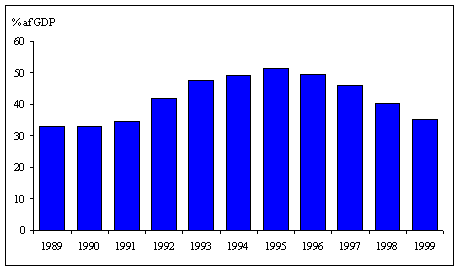
The debt ratio has not been lower since 1990, before the economic difficulties of the early 1990's began. Foreign Treasury debt is expected to amount to less than 100 billion krónur at the end of 1999, having declined by 36 billion krónur since 1996. Gross repayments of Treasury debt will amount to 27 billion krónur in 1999, only 12 billion of which will be refinanced in the market with issue of new debt. This decline in government debt is estimated to yield an annual saving in interest payments of close to 1 billion krónur a year. The division of repayments and refinancing of Treasury debt between domestic and foreign markets will be dictated by relative market conditions at home and abroad as well by monetary policy considerations in Iceland's financial market.
6. The medium-term outlook
The Ministry of Finance, in cooperation with the National Economic Institute, has for the several years gone through an exercise of medium-term economic and fiscal prospects. The present projection is based on the forecast of about 3% growth for the period 1999-2003. This is somehat less than has been forecast in the past two years, but slightly higher than in the average of neighbouring countries. Employment is forecast to rise and disposable household income is expected to increase by 1-1,5% a year in real terms. Exports are expected to increase by 3,5 % in volume per year, due to a rising fish catch and increased exports by power-intensive industry. Imports, however, are expected to increase less, or by 2,5% a year. The current account deficit could therefore decline in the medium term and is projected at 2,5% of GDP at the end of the period. Foreign debt is thought to increase due to heavy power investments; the debt-to-GDP ratio for the country as a whole is projected to reach 48,5%, about 2% above the 1998-level. Inflation is forecast to remain similar to the present level of 2-2,5%. Long-term interest rates may decline to 4,5% in real terms.
Medium-term projections 2000 - 2003
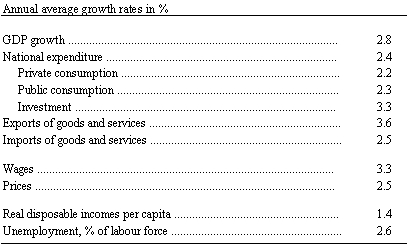
Based on this scenario, the extrapolation of Treasury finances indicates that the revenue balance will gradually improve and could be in surplus by 10 billion krónur on an accruals basis by the year 2003. The financial balance could be in surplus by 15 billion krónur in the same year which would make it possible to cut Treasury debt to 20% of GDP.
